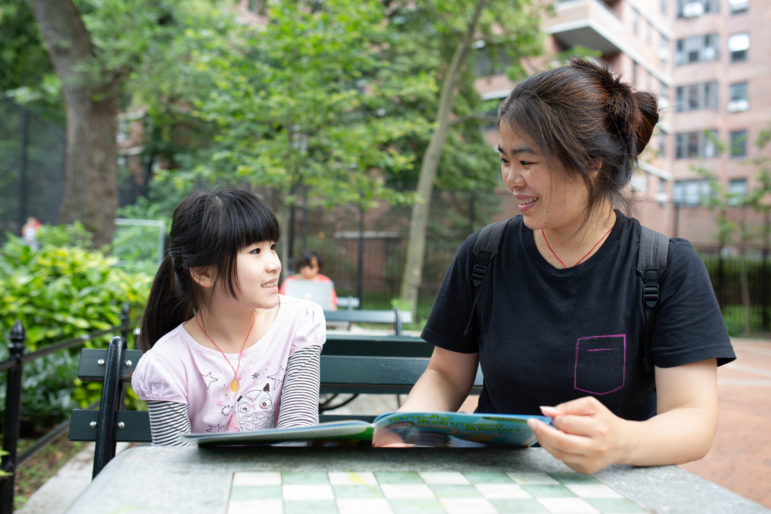Researchers said their findings counter a narrative that stimulus payments and unemployment benefits were “too generous” and disincentivized work.

Robert Winn
Ella Li reads a book with her daughter XiLan. Li said federal stimulus payments helped her cover rent and food for her family after she lost her jobs.After losing her two jobs at the start of the pandemic, Ella Li exhausted her savings to feed her daughter and cover rent in a Chinatown apartment.
Friends pitched in and shared food and her daughter’s school provided meals, but still her savings dwindled, she said. Then came a crucial cash infusion from the federal government.
“I could pay the rent with the stimulus check. It was very helpful for rent and food,” Li said Tuesday.
Li is one of roughly 1 million New Yorkers who avoided falling deeper into poverty last year with the help of federal stimulus payments and heftier unemployment checks, according to a new analysis from Hunter College, Columbia University and the Robin Hood Foundation’s Poverty Tracker team.
New Yorkers receiving unemployment insurance got an additional $300 per week from the federal government, as well as three separate payments through the Coronavirus Aid, Relief, and Economic Security (CARES) Act and the American Rescue Plan. Those payments helped keep the city’s poverty rate at 20 percent in 2020, up from 16 percent in 2019 but staving off what would have been an even steeper spike last year, reaching 35 percent without the relief aid, researchers found.
The report, published Wednesday, highlights the experiences of 38 low-income New Yorkers who managed to cover rent, buy food and pay down debts despite losing jobs and wages as a result of the pandemic. Columbia and Robin Hood’s Poverty Tracker team conducted interviews with each of the participants in roughly six-month intervals between July 2020 and May 2021 to learn more about the financial impact of the pandemic, and the way they used their stimulus and unemployment checks.
“Direct cash payments were the single most useful tool for helping people ride out the pandemic,” the report concludes. “It helped families pay their bills and often enabled parents to stay home to care for school-age children during remote school.”
Like Li, most participants said they used the money to cover rent and buy food. Others said the extra assistance helped them tackle mounting debts after accounting for their immediate needs. A 32-year-old woman named Lucia told researchers she managed to pay down her credit card bill from $15,000 to $8,000 between July 2020 and January 2021 with the help of additional unemployment insurance. Another woman, 39-year-old Maya, said she owed nothing to credit card companies before the pandemic but racked up $10,000 in debt after losing her job. She said she was able to pay a chunk of that with her federal stimulus checks.
The Poverty Tracker team previously found that nearly half of New York City workers, including 57 percent of low-wage workers, lost income early in the COVID-19 pandemic. About 52 percent withdrew from their savings to cover expenses, and 29 percent accrued additional credit card and loan debt—financial burdens that threatened to plunge them deeper into poverty.
In recent months, Li, an immigrant from China, became a U.S. citizen, continued taking English classes at Henry Street Settlement and applied for relief through New York’s Excluded Workers Fund. She said she returned to work in May, taking shifts at a Manhattan daycare center and a nearby grocery store.
The Poverty Tracker researchers said their findings counter a narrative that stimulus payments and unemployment benefits were “too generous” and disincentivized work.
“People are really interested in going back to work, but the situation is really complex and cash assistance addressed the complexities, like remote learning, childcare and switching jobs because the jobs they had are not coming back,” said Robin Hood Chief of Grant Strategy Sarah Oltmans.
Oltmans said the financial relief particularly helped mothers, like Li, who were forced to take on a disproportionate amount of childcare duties as they tried to earn a living.
“What jumped out to me the most was the balancing act for women, particularly mothers, who might be caring for children when childcare disappeared, caring for other family members and working part time,” she said.









